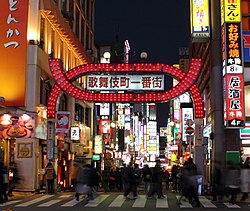Top Qs
Timeline
Chat
Perspective
Red-light district
Urban area with a high concentration of sex-related businesses From Wikipedia, the free encyclopedia
Remove ads
A red-light district or pleasure district is a part of an urban area where a concentration of prostitution and sex-oriented businesses, such as sex shops, strip clubs, and adult theaters, are found. In most cases, red-light districts are particularly associated with female street prostitution, though in some cities, these areas may coincide with spaces of male prostitution and gay venues.[1] Areas in many big cities around the world have acquired an international reputation as red-light districts.[2]

Remove ads
Origins of the term
Summarize
Perspective

Red-light districts are mentioned in the 1882 minutes of a Woman's Christian Temperance Union meeting in the United States.[3] The Oxford English Dictionary records the earliest known appearance of the term "red light district" in print as an 1894 article from the Sandusky Register, a newspaper in Sandusky, Ohio.[citation needed]
Author Paul Wellman suggests that this and other terms associated with the American Old West originated in Dodge City, Kansas, home to a well-known prostitution district during the 19th century, which included the Red Light House saloon.[4] This has not been proven, but the Dodge City use was likely responsible for the term's pervasiveness.[5] A widespread folk etymology claims that early railroad workers took red lanterns with them when they visited brothels so their crew could find them in the event of an emergency. However, folklorist Barbara Mikkelson regards this as unfounded.[6]

A commonly repeated, though likely spurious, folk etymology stems from sailors coming back from sea to Amsterdam (c. 1650): Women working as prostitutes, deprived of proper hygiene and running fresh water, carrying red lanterns — with their color camouflaging boils, zits, inequalities in the face and on the skin — made clear they were available as women of pleasure.[citation needed]
One of the many terms used for a red-light district in Japanese is akasen (赤線), literally meaning "red-line". Japanese police drew a red line on maps to indicate the boundaries of legal red-light districts. In Japanese, the term aosen (青線), literally meaning "blue-line", also exists, indicating an illegal district.
In the United States during the 19th and early 20th centuries, the term "sporting district" became popular for legal red-light districts. Municipal governments typically defined such districts explicitly to contain and regulate prostitution.[7]
Remove ads
Other uses
In World War I (circa 1915), "Brothels displayed blue lamps if they were for officers and red lamps for other ranks."[8]
Legal issues
Some red-light districts (such as De Wallen, Netherlands, or Reeperbahn, Germany) are places that are officially designated by authorities for legal and regulated prostitution.[2] Often, these red-light districts were formed by authorities to help regulate prostitution and other related activities, such that they were confined to a single area.[9]
Some red-light districts (such as those in The Hague)[10] are under video surveillance. This can help counter illegal forms of prostitution (such as child prostitution), in these areas that do allow regular prostitution to occur.

Decriminalization - No criminal penalties for prostitution
Legalisation – prostitution is legal and regulated
Semi-legal – prostitution is legal, but organized activities such as brothels and pimping are illegal; prostitution is not regulated
Quasi-legal – illegal to buy sex and for 3rd party involvement, legal to sell sex
Prohibitionism – prostitution illegal
Legality varies with local laws
Image gallery
- The Red Light District in Amsterdam
- Rooms illuminated by red lights in De Wallen, Amsterdam, Netherlands
See also
References
External links
Wikiwand - on
Seamless Wikipedia browsing. On steroids.
Remove ads






